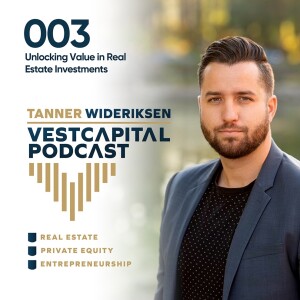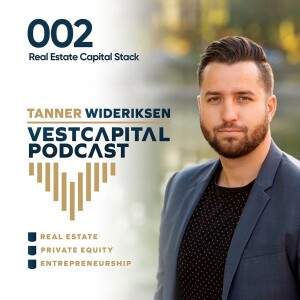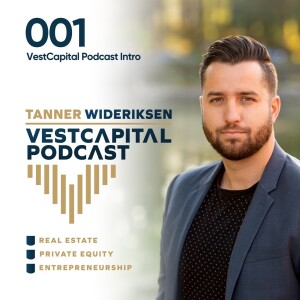VestCapital Podcast
Tanner Wideriksen sits square as the founder and managing partner of VestCapital. He places a high value on building the real estate investment and development firm with an entrepreneurial approach, having started and scaled 3 businesses since college, pushing through adversity with limited resources, and executing the company are part of his DNA. His primary roles at VestCap are predicated on; structuring investment offerings, development strategies, capital management, investor relations, civil/architectural design, municipality entitlements, risk management and growing assets under management. Leading with authenticity and passion, Tanner has successfully executed and engineered over 27 real estate investment offerings, raising both debt and equity with a meaningful aggregate retail finish value, all while mitigating investor risk and meeting or exceeding projected returns in both the residential and commercial real estate arena. Tanner resides in Camas, WA and enjoys exploring the Pacific Northwest with his wife and 2 kids, catching the lates MMA/UFC event and golfing.
Episodes

Tuesday Apr 29, 2025
Tuesday Apr 29, 2025
In this episode, we dive into a conversation with Max Quinn, a rising real estate professional with a unique journey from athletics to development. He shares how adversity, hustle, and a strategic mindset helped him break into the world of real estate and thrive at Vest Capital.
1. Max’s Personal and Professional Background
- Passion for real estate started in high school, leading to multiple internships in brokerage.
- A traumatic sports injury in junior year became a turning point, sparking deeper focus on long-term goals.
- Landed a pivotal role with a top real estate developer in Oahu during college.
- Developed skills in land acquisition and sales while balancing school full-time.
- Moved back to the mainland and proactively sought opportunities at Vest Capital.
2. Breaking Into Development
- Max landed his Hawaii job through persistence, networking, and follow-up.
- Took initiative to walk in, drop resumes, and follow up when others wouldn't.
- Shared the importance of being transparent, coachable, and aligned with entrepreneurial values.
- Emphasizes the role of mindset and risk-taking in career growth.
3. Mindset and Motivation
- Credits his life-threatening injury for creating the space to rethink his path.
- Believes adversity sharpens focus and builds resilience.
- Draws inspiration from nature and solo sports like skiing and surfing for balance and clarity.
- Practices intentional thinking to maintain alignment with his long-term vision.
4. Role at Vest Capital
- Started in investor relations—raising capital, structuring debt/equity, and working through fund mechanics.
- Transitioned into land acquisition—negotiating directly with owners and structuring creative deals.
- Finds synergy between investor relations and acquisitions, helping him build holistic deal experience.
- Values optimizing outcomes for both the firm and investors.
5. Hustle, Deal-Making, and Strategy
- Recently closed an off-market deal with a legacy landowner through relationship-building and cultural awareness.
- Tailored his approach by reading social cues—adapting from "suit and tie" to "boots and flannel" communication style.
- Learned how to creatively structure the capital stack and reduce firm costs through strategic financing.
- Highlights the value of being authentic, persistent, and detail-oriented in deal negotiations.
This episode offers powerful takeaways on breaking into real estate, mastering investor communication, and navigating land deals through relationship-driven strategies. Max’s journey is a testament to grit, initiative, and the importance of staying aligned with your "why."

Friday Jan 10, 2025
Friday Jan 10, 2025
In this episode, we dive into a conversation with Arthur, a real estate developer and mentor. He shares his strategies for building teams, leveraging experience, and using personal branding to scale his business.
1. Arthur’s Professional Journey
Began in Portland and Vancouver with residential and mixed-use developments.
Expanded into mentorship and nationwide partnerships.
Refined processes through lessons learned, creating efficient SOPs.
Focuses on empowering small businesses to address the housing shortage.
2. Team-Building and Leveraging Expertise
Advocates for a culture where the best ideas and talent lead.
Prioritizes hiring experienced professionals to reduce risks.
Shared success cutting project timelines with seasoned managers.
Stresses the value of working with experts familiar with local markets.
3. Mindset and Problem-Solving in Business
Stresses a growth mindset to overcome challenges and scale.
Uses daily affirmations to maintain focus on long-term goals.
Believes effective leaders solve problems to sustain growth.
4. Scaling Through Partnerships and Expansion
Partners with mentees to expand into new markets.
Leverages local expertise to reduce risks in new regions.
Plans large-scale projects like a 50-lot subdivision.
Promotes collaboration over competition to empower small businesses.
5. The Role of Personal Branding
Uses social media to grow his brand and business (@arthurthedeveloper).
Documents projects and shares insights to engage audiences.
Encourages others to build trust and influence through online presence.
Believes personal branding is now key in modern development.
This episode offers practical insights into real estate development, team building, and leveraging personal branding to create lasting impact.

Wednesday Oct 30, 2024
Wednesday Oct 30, 2024
In this episode, we explore a fireside chat with Trevor, a CPA specializing in real estate and construction, discussing tax strategies and investment considerations for high-net-worth individuals and real estate investors.
1. Trevor's Professional Background** - Started career in the Bay Area with a focus on high-net-worth individuals - Specialized in construction and real estate taxation - Established his own CPA firm after 10 years of strategic learning - Currently based in the Lake Oswego area2. Tax Strategies for High-Net-Worth Individuals** - Basic strategies include 401(k) deferrals - Advanced options like SEP plans with up to $66,000 deduction - Cash balance plans for larger deductions - Real estate investment strategies including self-rental arrangements - Material participation real estate professional classification benefits3. Real Estate Investment Considerations** - Benefits of portfolio diversification through real estate - K-1 partnership structure explanation - Tax advantages through depreciation and bonus depreciation - Importance of strategic planning for taxable events - Value of clear communication between sponsors and investors regarding hold periods and projected returnsThis episode provides valuable insights for business owners and investors looking to optimize their tax strategy through real estate investment while highlighting the importance of professional guidance in structuring these investments.

Monday Sep 02, 2024
Monday Sep 02, 2024
In this episode, we explore the historical origins of the carried interest role, dating back to the Renaissance era, and how VestCapital adopts a similar approach today. By aligning its risk profile with investors through profit-sharing structures, VestCapital ensures mutual success, drawing parallels between the investment strategies of Venetian sailors and modern real estate funding.
Investment Deal Structure at VestCapital
VestCapital structures its investment deals to align the interests of both the company and its investors.
The approach ensures that when VestCapital performs well, the investors also see benefits.
This alignment of interests aims to "rise all ships," fostering mutual success.
Historical Origin of the Standard Carried Interest Role
The concept traces back to the 16th century during the Renaissance era.
Venetian investors provided capital to sailors who undertook risky voyages to purchase and trade spices.
Profits were split 80/20, with 20% going to the investor, establishing an early model for shared profits.
Parallels Between Renaissance Investment and Modern Practices
Just as Venetian investors backed entrepreneurs in risky ventures, VestCapital backs modern entrepreneurs by providing necessary capital.
The 80/20 profit split model is mirrored in VestCapital's approach to aligning with investors' goals.
This method of structuring deals ensures that both parties share in the risks and rewards of the investment.

Monday Aug 19, 2024
Monday Aug 19, 2024
In this episode of the VestCapital podcast, host Tanner Wideriksen delves into the intricacies of the capital stack within private equity, specifically focusing on different financing layers: senior debt, mezzanine financing, preferred equity, and common equity. He explains the roles and risk profiles of each, emphasizing their importance in real estate development. Tanner highlights that senior debt carries the least risk with the first claim on assets, while common equity, often held by sponsors, is the riskiest but aligns developer and investor interests. The discussion centers on how these layers impact investment strategies, particularly in short-term real estate projects, typically spanning 36 months. Tanner concludes by stressing the importance of aligning interests between developers and investors to ensure project success.

Monday Aug 19, 2024
Monday Aug 19, 2024
In this podcast episode, host Tanner Wideriksen reflects on the month’s focus on the private equity component of the capital stack. He discusses the different elements of the capital stack and how various investors prefer to allocate their resources. Tanner shares his experience working with long-term investors and how VestCapital tailors investment opportunities to meet their evolving needs. He highlights a unique approach where VestCapital reverse engineers investment preferences to provide personalized deals that align with both the investors' goals and the company's objectives, ultimately benefiting all parties involved.

Monday Aug 19, 2024
Monday Aug 19, 2024
The podcast episode provides an in-depth discussion on the capital stack involved in a recent large-scale real estate acquisition by VestCapital. Host Tanner Wideriksen explains how they structured the deal, emphasizing the importance of understanding how the capital stack is arranged, particularly for investors in commercial real estate. The project involved acquiring three multifamily buildings and identifying additional legal lots, which allowed for further development opportunities.
Tanner elaborates on the different financing layers, including senior debt, preferred equity, and a construction holdback loan. He highlights the importance of cautious leverage to ensure the project can service its debt, even if the market downturns. The episode concludes by discussing the project's timeline, with plans for additional development and a potential liquidity event for investors in the form of a sale or refinance, where they will receive their principal investment plus a share of the profits.

Wednesday Aug 14, 2024
Wednesday Aug 14, 2024
In real estate, the capital stack refers to the hierarchy of financial layers or types of capital that are used to finance a property investment. Each layer in the capital stack has a different level of risk and return, with the order of the layers representing the priority of payment.
Here’s a breakdown of the main components of the capital stack:
Senior Debt:
Position in Stack: Bottom layer
Description: This is usually the primary loan or mortgage financing provided by a commercial bank or other traditional lender. It has the lowest risk because it's secured by the property itself, meaning the lender can take possession of the property if the borrower defaults.
Return: Typically the lowest return (interest rate) due to the lower risk.
Payment Priority: First in line to be paid.
Mezzanine Debt:
Position in Stack: Above senior debt, but below equity.
Description: This is a secondary layer of debt that carries more risk than senior debt but less than equity. Mezzanine lenders do not have a claim on the property itself but may have rights to the borrower’s equity in the property if there is a default. This type of debt is often used when the senior lender restricts the amount of senior debt.
Return: Higher interest rates than senior debt due to increased risk.
Payment Priority: Paid after senior debt but before equity.
Preferred Equity:
Position in Stack: Above mezzanine debt, but below common equity.
Description: Preferred equity investors are equity holders with a preferred position over common equity holders. They receive returns after all debt obligations are satisfied but are typically promised a minimum return before common equity holders are paid.
Return: Higher than mezzanine debt, often fixed, with less risk compared to common equity.
Payment Priority: After all debt, before common equity.
Common Equity:
Position in Stack: Top layer.
Description: Held by the sponsor of the real estate deal and potentially other equity investors, common equity holders take on the most risk since they are the last to be paid. However, they also have the highest potential upside if the investment performs well, as they are entitled to all remaining profits after everyone else in the capital stack has been paid.
Return: Potentially the highest, but with the most risk.
Payment Priority: Last in line to be paid.
The capital stack structure is important for understanding the risk and return profile of an investment and how different investors or lenders are positioned in terms of priority for repayment.

Wednesday Aug 14, 2024
Wednesday Aug 14, 2024
We are a technology-driven real estate private equity investment and development firm that acquires, manages, and sells a diversified portfolio of assets. Our business model transforms commercial real estate investing by providing a platform where investors may directly access institutional-quality assets and build wealth passively.








